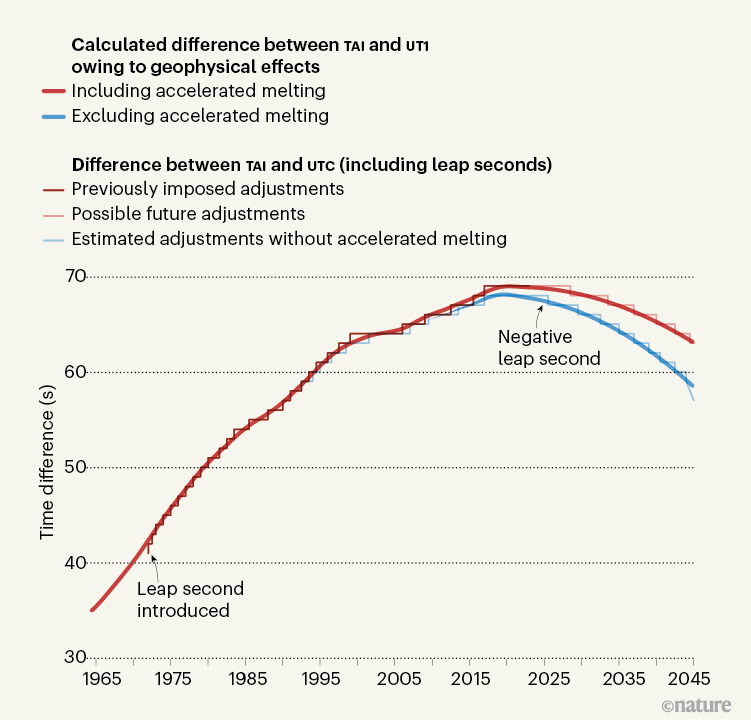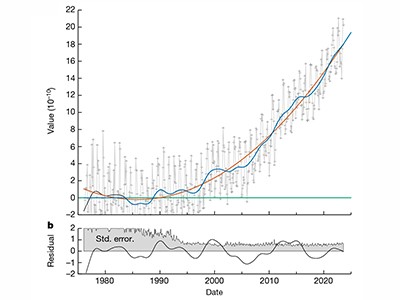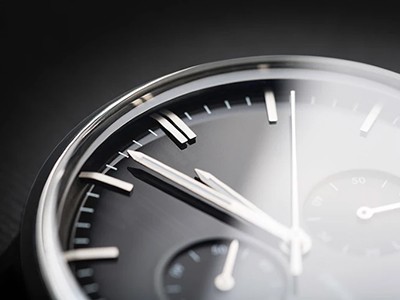[ad_1]
THE TOPIC IN BRIEF
• Timekeeping is determined by ultraprecise devices called atomic clocks, but it is also aligned with Earth’s rotation, mainly for historical reasons.
• Because the planet’s rate of rotation fluctuates, this alignment is maintained with the occasional addition of ‘leap seconds’ to the official time standard.
• Now, Earth’s rotation seems to have accelerated, outpacing the time standard, and raising the possibility that an unprecedented ‘negative’ leap second might soon be required — a daunting prospect in a world reliant on consistent timekeeping.
• Agnew1 reports that human-induced melting of polar ice exerts a slowing effect on Earth’s rotation, effectively delaying a decision on the need for a negative leap second.
PATRIZIA TAVELLA: International timekeeping
In 1967, the internationally accepted definition of the second changed. The time measurement standard had been linked to Earth’s rotation, but instead became determined by a quantum transition between two states of a caesium atom. The change was motivated by accuracy: caesium atomic clocks keep time on the basis of the ultrastable frequency of the photons exchanged in the quantum transition. This seemed like a safer bet than Earth’s movements, which weren’t as regular as was first assumed.
Read the paper: A global timekeeping problem postponed by global warming
But sailors still relied on the Sun and stars to navigate, and they wanted a time standard that remained tied in some way to Earth’s rotation. It was therefore decided that the new international reference, known as coordinated universal time (utc), would be set by atomic clocks, but kept apace with the rotational angle of Earth, which is known as universal time (ut1). Since 1972, utc has been adjusted to meet this goal by adding a leap second whenever the discrepancy between the two standards approaches one second.
Atomic clocks have enabled the development of great technologies, such as satellite navigation and, in an age of the global navigation satellite system (GNSS), celestial navigation is much less relevant than it was in 1972. GNSS satellites themselves have onboard atomic clocks that regulate their timekeeping, and the insertion of a leap second generates risk of failures. Perhaps more importantly, the addition of leap seconds can have drastic effects on computer infrastructure in the increasingly connected modern world (see go.nature.com/44y88yp).
For these reasons, after more than 20 years of discussion, metrologists proposed that utc be kept in line with Earth’s rotation, but that the tolerance for adding an adjustment be increased to a value larger than one second2. This proposal, which delays the need to make any adjustment for at least another century, was adopted by the General Conference on Weights and Measures (CGPM) in 2022.
The CGPM resolution stipulates that the maximum difference between the two times (denoted ut1 − utc) will be increased in or before 2035, and that the details of the new maximum and how it is to be implemented will be decided at the next CGPM meeting in 2026 (see go.nature.com/3vqddy2). Most delegates urge a quick implementation of the new rules, although others ask for more time to adapt their systems. The radiocommunication sector of the International Telecommunication Union — the organization that regulates the transmission of time signals — endorsed the CGPM decisions at the World Radiocommunication Conference in 2023.
utc is currently computed using data from about 450 atomic clocks, which are maintained in more than 80 institutions around the world. It is disseminated in real time by these time laboratories, by means such as radio or telephone signals, the Internet or optical fibre protocols, and also through GNSS signals. Since 1972, irregularities in Earth’s movement have called for 27 leap seconds to be added — at irregular intervals and with a maximum of only 6 months’ notice each time. The irony is that metrologists now face the challenge of removing a leap second from utc for the first time, because Earth’s rotation is gradually getting faster than the time standard set by atomic clocks (Fig. 1).

Figure 1 | Synchronizing the international time with Earth’s rotation. Agnew1 calculated the difference between international atomic time (tai), which is measured using ultraprecise quantum devices known as atomic clocks, and universal time (ut1), which is determined by Earth’s rotation. tai, with the addition of occasional ‘leap seconds’, defines coordinated universal time (utc), which is kept in alignment with ut1. Earth’s current rate of rotation suggests that the first negative leap seconds might soon be necessary owing to a combination of geophysical effects. Agnew’s calculation shows that accelerated melting of the polar ice caps has delayed the need for these adjustments. (Adapted from Fig. 2d of ref. 1.)
A negative leap second has never been added or tested, so the problems it could create are without precedent. Metrologists around the world are following the unfolding discussion attentively, with the view to avoiding any unnecessary risks. What would be necessary, as in good metrological practice, is to calculate the uncertainty associated with predictions of Earth’s rotation. This information would allow researchers to evaluate the probability that a negative leap second will be required — and assess the related risks — so that they can anticipate any such change before 2035. Unfortunately, this task remains formidable (ref. 3 and go.nature.com/4armrvz), so Agnew’s suggestion that the change could be delayed is welcome news indeed.
JERRY X. MITROVICA: In search of lost time
Earth’s rotation is an imperfect timekeeper. This imperfection is imperceptible to humans, but the exquisite accuracy of atomic clocks makes it clear that the time taken for the planet to make one full turn varies from day to day.
On a millennial timescale, changes in Earth’s rotation reflect the combined effect of three geophysical processes4. First, friction between ocean water and the sea floor — both in shallow seas and in the deep ocean — has progressively slowed Earth’s rotation. This effect is known as tidal dissipation. Second, since the last ice age ended, Earth has undergone shape adjustments that have increased its rotation rate. These ongoing changes have brought the planet back to a shape that is more spherical than the flattened form it took when massive ice sheets existed in its polar regions. Finally, the coupling between Earth’s iron core and its outer rocky mantle and crust means that any change in the angular momentum of the core must be balanced by a change of equal magnitude and opposite sign in the mantle and crust.
The leap second’s time is up: world votes to stop pausing clocks
Although the individual contribution of each process is somewhat uncertain, their sum is known precisely: it has led to an increase in Earth’s rotation period of 6 millionths of a second per year4. This slowing might seem trivially small, but its effect is responsible for a phenomenon known as clock error. This error describes a discrepancy in the timing of eclipses: events recorded by ancient astronomers seem to have occurred at times that differ from those predicted by assuming that Earth’s rotation rate has remained unchanged since ancient times. Clock error increases with the age of the eclipse and reaches around 4 hours for eclipses that were observed 2,500 years ago5.
The effects of tidal dissipation and shape adjustments have not changed appreciably since the advent of modern atomic timekeeping, but the impact of core–mantle coupling on Earth’s rotation varies on multiple timescales as a result of the fluid nature of the outer core. And herein lies the probable cause of timekeeping’s most recent dilemma: leap seconds have been required with much lower frequency since 2000 than in the previous 30 years, which indicates that Earth’s rotation rate is accelerating. Given the stability of tidal dissipation and shape-adjustment effects over this period, the main culprit must be core–mantle coupling. However, Agnew’s findings suggest that there is another factor at play.
Agnew analysed changes in Earth’s rotation and in its gravity field — changes in the latter arising through the redistribution of mass on Earth’s surface. His analysis demonstrates persuasively that core–mantle coupling has led to accelerated rotation, but that there has also been a pronounced deceleration owing to the onset of major melting of polar ice sheets that began near the end of the twentieth century. This human-induced process is slowing rotation by moving melted ice mass from the poles to lower latitudes.
Core–mantle coupling alone could have necessitated a negative leap second in about two years’ time. According to Agnew’s calculations, changes in polar ice mass have delayed this eventuality by another three years, to 2029. But no realistic projection of future ice-mass changes will thwart the need for a negative leap second beyond the next decade. Unless international timekeeping guidelines change soon, the myriad technological foundations of human society must be updated in preparation for this unprecedented event, and for the disappearance of 23:59:59 on a single day in the not-too-distant future.
[ad_2]
Source Article Link



